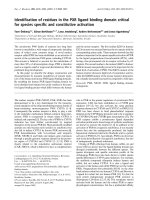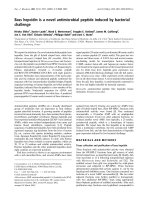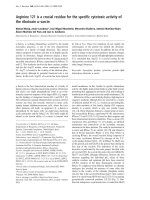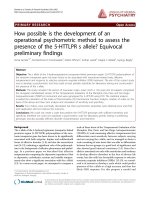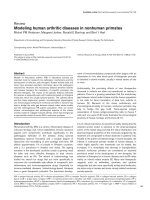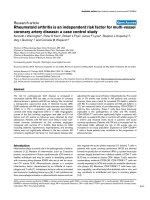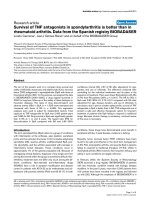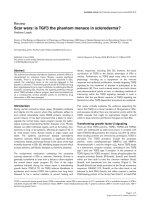Bóa cáo y học: "Time-point measurement is critical in hormone characterization" ppsx
Bạn đang xem bản rút gọn của tài liệu. Xem và tải ngay bản đầy đủ của tài liệu tại đây (30.81 KB, 2 trang )
Page 1 of 2
(page number not for citation purposes)
Available online />In their recent study ‘Changes in appetite related gut
hormones in intensive care unit patients: a pilot cohort study’
Nematy and colleagues further elucidated intensive care unit
(ICU) patients’ poor nutritional status. They reported high
levels of peptide YY (PYY) and low levels of ghrelin in fasting
plasma samples from ICU patients compared with healthy,
nonhospitalized controls [1]. While intriguing, this gives only a
mere snapshot of PYY/ghrelin physiology in the ICU patient
because PYY/ghrelin levels were measured only once per day.
The pattern of plasma ghrelin levels during a 24-hour period
in human subjects was previously characterized, in which
samples were taken at intervals of 30–60 min throughout the
day. Results revealed a preprandial rise and a postprandial
decline in ghrelin, characteristic of a natural rhythm related to
food intake [2]. PYY secretion was conversely defined as
involving a low fasting level followed by a postprandial rise,
which peaked 1 hour after food ingestion and was influenced
by meal type and meal size [3].
The implications of measuring these gut peptides in fasting
individuals only once per day in the morning is an incomplete
representation of the physiology of these hormones in the
complicated ICU patient. Observing the hormone levels at
multiple time points could result in three possible scenarios
and could lead to different treatment options. The first
hypothesis is a steady baseline state with no rhythmic
phenomenon associated with food intake. This possibility,
while unlikely, must be considered, since some semblance of
normal physiology, albeit inadequate, is usually preserved in
the ICU patient.
A second possibility is a rhythmic response in which peaks
and troughs reach the same levels as in control subjects
while still exhibiting a higher/lower baseline state. This is
representative of a suboptimal physiologic response. A
rhythmic response may still be present but sufficient hormone
levels are not reached, resulting in a less potent stimulus
leading to a depressed response. This is the most probable
case as it is possible that the hormone response in critically ill
patients may be inadequate. This could therefore hold true for
PYY/ghrelin responses, in which normal stimuli do not
enhance the hormone response.
Finally, these hormones could have baselines that are
elevated or depressed relative to controls and could also
reach peaks/troughs that are still higher/lower than controls.
This would reflect the patients’ retention of a normal
physiologic rhythm in response to meals even though
baseline levels are altered. It is suspected that this final
scenario would not be the case as this would yield a normal
response to feeding, and possibly a normal nutritional state.
It is therefore essential that preprandial and postprandial
measurements be taken to better illustrate this physiology.
This would then lend credence to the possibility that the
rhythmic release of PYY/ghrelin is more important than
baseline levels.
The physiology of ICU patients is a complicated puzzle, one
confounded by innumerable variables. To look at a single
time point for gut peptide characterization — let alone any
hormone — is insufficient and perhaps misleading. With the
expansion of time points and sample numbers, consideration
of the three aforementioned hypotheses is warranted. It is
believed that the new data from these suggestions will help
to further unlock the mystery that is the nutritional status of
the ICU patient.
Letter
Time-point measurement is critical in hormone characterization
Samuel Colby Danna
Louisiana State University Health, Sciences Center in New Orleans, Pennington Biomedical Research Center, Baton Rouge, Louisiana, USA
Corresponding author: Samuel Colby Danna,
Published: 27 April 2006 Critical Care 2006, 10:411 (doi:10.1186/cc4914)
This article is online at />© 2006 BioMed Central Ltd
See related research by Nematy et al. in issue 10.1 [ />ICU = intensive care unit; PYY = peptide YY.
Page 2 of 2
(page number not for citation purposes)
Critical Care Vol 10 No 2 Danna
We would like to thank Dr Danna for his interest in our paper.
He commented that ‘measuring these gut peptides in fasting
individuals only once per day in the morning is an incomplete
representation of the physiology of these hormones in the
complicated ICU patient’. We would therefore like to draw
Danna’s attention to the following points.
This was a pilot study in a group of intensive care patients.
The idea of publication was to encourage debate around the
role of gut hormones in this area, and to alert colleagues to
our early findings. This was the first report in this field. We
recognize the weaknesses of measuring one time point for
gut hormones, but at the outset of the study we did not even
know that interpretable data would be produced.
Previous publications from our group have defined the dynamic
relationship between gut hormones, appetite and food intake
[4-7]. We are aware that a detailed understanding requires the
assessment of response to feeding, often achieved with a test
meal. ICU patients tend to be fed continuously, however, thus
rendering test meals practically difficult and of arguable
significance. What is clear is that our understanding of
appetite, food intake and the physiological mechanisms of the
regulation of the same are poorly understood, and this is
particularly important in recovering patients after discharge.
This is a clear avenue for future studies.
We are not claiming to have anything like the whole answer
with this pilot study, but suppressed ghrelin and elevated
PYY may contribute to a reduced initial motivation to eat. We
named this a pilot study and subsequently designed two
investigations to examine the initial hypothesis and to explore
the possible mechanism of observed changes in gut
hormones in acute illness. These investigations were
performed in elderly patients with a fractured neck of femur
and in patients undergoing coronary artery bypass grafting
surgery. Results were encouraging and will be submitted
shortly for publication.
Authors’ response
Mohsen Nematy, Jacqui E O’Flynn, Liesl Wandrag, Audrey E Brynes, Stephen J Brett, Michael Patterson, Mohammad
A Ghatei, Stephen R Bloom and Gary S Frost
Competing interests
The authors declare that they have no competing interests.
References
1. Nematy M, O’Flynn JE, Wandrag L, Brynes AE, Brett SJ, Patterson
M, Ghatei MA, Bloom SR, Frost GS: Changes in appetite
related gut hormones in intensive care unit patients: a pilot
cohort study. Crit Care 2006, 10:R10.
2. Cummings DE, Purnell JQ, Frayo RS, Schmidova K, Wisse BE,
Weigle DS: A preprandial rise in plasma ghrelin levels sug-
gests a role in meal initiation in humans. Diabetes 2001, 50:
1714-1719.
3. Adrian TE, Ferri GL, Bacarese-Hamilton AJ, Fuessl HS, Polak JM,
Bloom SR: Human distribution and release of a putative new
gut hormone, peptide YY. Gastroenterology 1985, 89:1070-
1077.
4. Batterham RL, Cowley MA, Small CJ, Herzog H, Cohen MA, Dakin
CL, Wren AM, Brynes AE, Low MJ, Ghatei MA, et al.: Gut
hormone PYY(3-36) physiologically inhibits food intake.
Nature 2002, 418:650-654.
5. Le Roux CW, Ghatei MA, Gibbs JSR, Bloom SR: The putative
satiety hormone PYY is raised in cardiac cachexia associated
with primary pulmonary hypertension. Heart 2005, 91:241-
242.
6. Le Roux CW, Patterson M, Vincent RP, Hunt C, Ghatei MA,
Bloom SR: Postprandial plasma ghrelin is suppressed propor-
tional to meal calorie content in normal-weight but not obese
subjects. J Clin Endocrinol Metab 2005, 90:1068-1071.
7. Wren AM, Seal LJ, Cohen MA, Brynes AE, Frost GS, Murphy KG,
Dhillo WS, Ghatei MA, Bloom SR: Ghrelin enhances appetite
and increases food intake in humans. J Clin Endocrinol Metab
2001,86:5992-5995.


